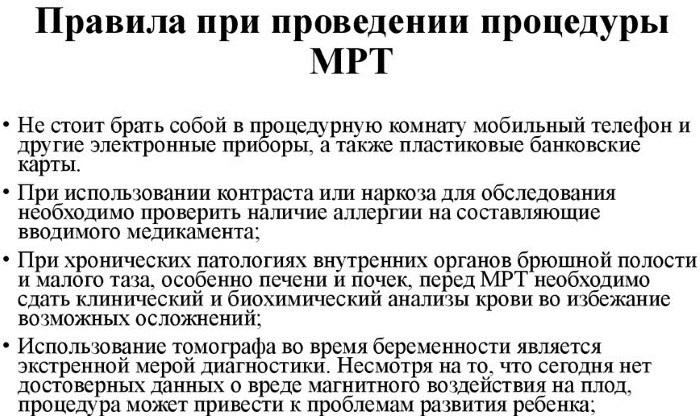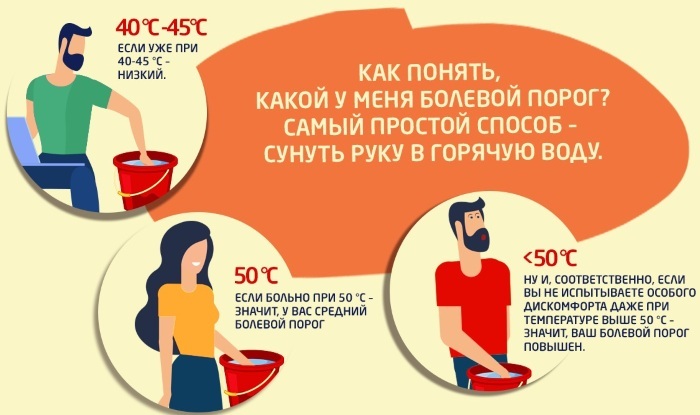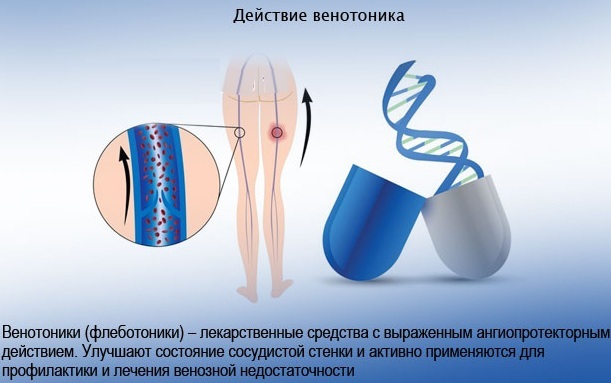Botulism is a very dangerous infectious disease that occurs in adults and children, characterized by poisoning of the body botulinum toxin after eating certain foods. Symptoms develop quite quickly, greatly worsen the patient's condition, and can be fatal if left untreated.
Record content:
- 1 Views
- 2 Stages and degrees
- 3 Symptoms
- 4 Reasons for the appearance
- 5 Diagnostics
- 6 When to see a doctor
- 7 Prophylaxis
-
8 Treatment methods
- 8.1 Medications
- 8.2 Folk methods
- 8.3 Other methods
- 9 Possible complications
- 10 Botulism videos
Views
There are several types of pathological conditions, depending on the origin and characteristics of the course. Some of the varieties are quite rare.
| Type of disease | Peculiarities |
| Food | This type of pathology occurs most often, since pathogens in most cases are found in food. It is worth noting that it is almost impossible to determine the presence of bacteria in food by external signs. This is the greatest danger. The disease is severe, often complicated and can be fatal |
| Respiratory type | This type of disease is less common, characterized by a predominant depression of the respiratory function, which will certainly lead to complications from other organs and systems. As a rule, the patient notices the first violations within a few hours after the penetration of pathogens into the body. |
| Undefined view | With the development of this type of pathology, it is almost impossible to establish the cause of the infection. Patients develop symptoms similar to classic botulism, but have distinctive features that indicate a different origin of the disease |
| Child | Botulism in children occurs before the age of 6 months, is severe and can cause death. However, this type of disease is very rare. |
| Ranevoy | Another very rare type of disease, when the wound surface becomes the focus of the lesion. In this case, the patient does not consume contaminated foods or drinks, therefore, the lesion of the digestive tract occurs somewhat later. Than with the classic course of poisoning |
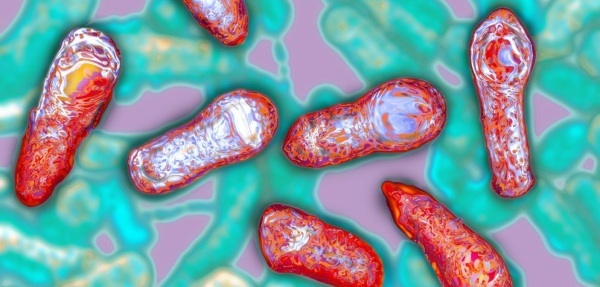
Additionally, doctors distinguish an uncomplicated and complicated form of a pathological condition. In the first case, the disease is mild, after recovery, there are no consequences. In the second case, after the disappearance of acute symptoms, the patient is disturbed by the disorders provoked by the toxin.
Stages and degrees
Botulism in an adult, the symptoms of which appear almost immediately after infection, proceeds in several stages. In this case, the type of disease does not matter, but in different patients the transition from one degree to another can occur at a different rate, which depends on the individual characteristics of the organism. The incubation period lasts from 3 to 36 hours.
At the initial stage, the symptoms are mild, a slight increase in temperature is possible, as well as disorders of the visual apparatus. The patient is considered signs of fatigue or mild food poisoning, does not visit the doctor, can take any medication on his own. As a rule, the mild stage lasts no more than 3 days.
The progressive stage is accompanied by the development of severe symptoms, lasts up to 3 weeks. In this case, the patient feels all the signs of poisoning, but the body temperature does not rise.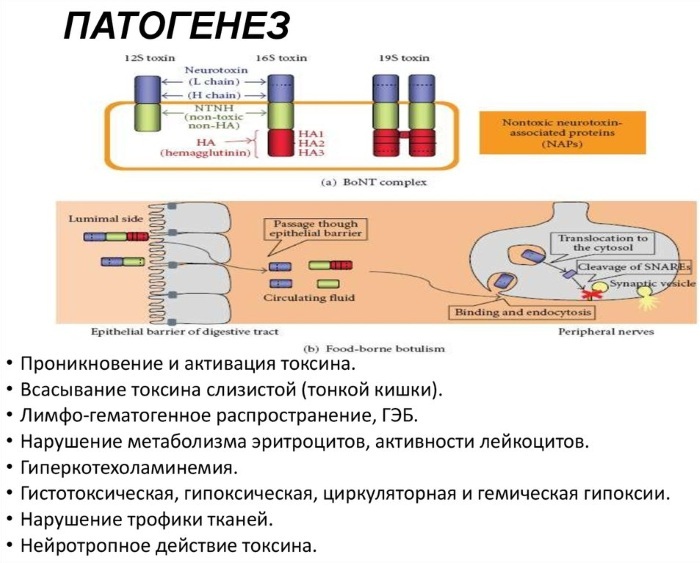
Without special diagnostics, it is almost impossible to detect the presence of toxins in the body, since the clinical picture resembles ordinary food poisoning. In the advanced stage, there are no respiratory symptoms.
After this, the disease goes into an advanced stage, symptoms from the respiratory system join. It is at this stage that complications appear, and the threat to the patient's life also increases. Usually the advanced stage lasts no more than 3 days, after which death occurs.
Symptoms
After the penetration of the pathogen into the patient's body, its active reproduction begins and the release of a very poisonous botulinum toxin, which leads to the appearance of symptoms. At the initial stage, the patient is worried about weakness, headache, dizziness.

A little later, a sharp, severe pain in the central part of the abdomen, as well as diarrhea, join. As a rule, in the initial stages, stool can be from 5 times a day, but in some patients, emptying occurs 10 times a day.
In addition, diarrhea is accompanied by frequent vomiting, which interferes with the intake of food and even liquids. All foods and drinks that enter the stomach do not stay in it for more than 15-20 minutes. Since the liquid is not absorbed in the body, symptoms of dehydration appear, manifested in the form of intense thirst and dryness of the mucous membranes in the mouth.
It should be noted that with botulism, an increase in body temperature to critical indicators is noted only on the first day. after the onset of symptoms. Further, the body temperature is normalized, which is not observed with other types of poisoning.
Almost all patients report double vision, decreased visual acuity and involuntary drooping of the upper eyelid, which is called ptosis in medicine.
In many patients, the immobility of the eyeballs is gradually replaced by their involuntary twitching.
Even when trying to open the eyes normally, the patient feels discomfort.
Additionally, the timbre of his voice changes, his speech becomes hoarse and slow, the patient cannot formulate his thought.
As a rule, the patient has difficulty swallowing from the first days of the development of the pathology. The first 2 days he refuses solid food, but gradually the condition worsens, a person cannot even swallow liquid. Failure to replenish water deficit leads to worsening of symptoms.
One of the most severe manifestations of botulism is the weakening of the muscle tone of the diaphragm, the whole body. In this case, the patient is constantly in a horizontal position, when trying to take a sitting position, there is an inability to hold his head due to weakening of the neck muscles. The patient is forced to support his head with his hands.
Among the external symptoms, pallor of the skin, drooping of the eyelids can be distinguished. The patient adheres to bed rest almost all the time, his face resembles a motionless mask, his eyes are half-open, his eyeballs are motionless or twitch involuntarily.
Respiratory disorders join at an advanced stage, while the patient is not able to normally inhale and exhale air, which leads to oxygen starvation of tissues, especially headache brain.
As a rule, at this stage, the patient completely refuses food, is unable to take liquid. Despite this, vomiting and loose stools are present several times a day. In many patients, diarrhea is replaced by constipation, which is associated with atony of the muscles of the digestive tract as a result of damage to the vagus nerve.
Reasons for the appearance
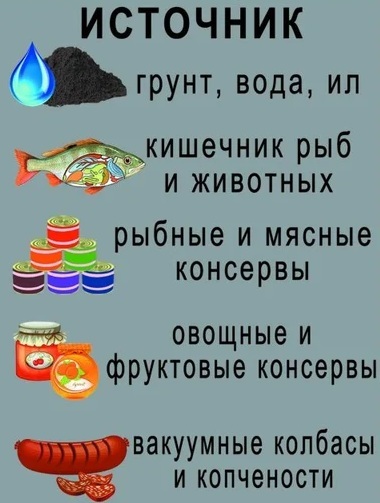
Botulism in an adult (symptoms most often develop rapidly) occurs only as a result of ingestion of a pathogen, namely the microorganism Clostridium botulinum.
Moreover, any type of disease develops for this very reason.
The food type is considered a consequence of the penetration of a microbe with food, a child develops by inhaling dust in which the pathogen is present.
Wound botulism occurs when a microorganism enters an open wound, respiratory botulism occurs when it is inhaled.
If the route of entry of the pathogen cannot be identified, they speak of unspecified botulism.
It is worth noting that the microorganism is very stable in the external environment, tolerates low and high temperatures, moisture and dryness well, remains in food for 12 months.
The food-borne type of illness is considered the most common; it occurs when a person eats foods that have not undergone proper heat treatment.
The most common causes are the following foods:
- Sausages.
- Canned vegetables and fruits.
- Stew.
- Canned fish, mushrooms.
- Canned legumes.
- Raw, smoked or dried fish.
- Incorrectly cooked meat.
- Dairy.
Only in some cases is honey that has been improperly collected or stored as the cause. It is worth noting that the danger is not the microorganism itself, but the toxin, which is a product of its vital activity. Today this substance is recognized as one of the most dangerous poisons.
It is important to know that the products containing the toxin do not change color or smell, which makes the pathology even more dangerous. Experts say that vegetables, fruits, meat and other products are the most dangerous. cooked at home in violation of the basic rules, insufficient thermal processing.
Diagnostics
Botulism is difficult to diagnose in its early stages in an adult based on symptoms alone. That is why several methods are used that help to clarify the presence of the pathogen and its toxin in the body.
Most effective methods:
- General examination and questioning is considered the first stage of diagnosis. The method helps to determine the most pronounced symptoms, to clarify the time of their occurrence, as well as accompanying factors. Quite often, the doctor manages to determine the product that the patient has consumed the day before. In addition, a specialist examines the patient, assesses the condition of the skin, muscles, and measures body temperature. Diagnostics is carried out free of charge at a state clinic.
- Clinical examination of blood and urine to assess the general condition of the patient is considered a standard and necessary diagnostic method. It is carried out in private and public clinics, in the first the cost is about 300 rubles. As a rule, the result shows abnormalities, signs of inflammation in the form of an increase in the level of leukocytes and erythrocyte sedimentation rate.
- A biochemical blood test is also considered an effective diagnostic method. It is carried out in any medical institution, in a private clinic the price is approximately 250-300 rubles. Blood is taken from the patient's vein, after which it is examined under laboratory conditions. The method helps to see deviations from the digestive tract and kidneys, which will certainly develop with the advanced course of botulism.
The most effective method is considered to be a special analysis of biological fluids, which makes it possible to identify botulinum toxin in them. Usually, the procedure is carried out free of charge at a public hospital.
However, the diagnosis takes about 4 days and is carried out using laboratory mice. That is why, when typical signs of botulism appear, treatment is started before the results of the study are obtained.
The essence of the diagnosis is the introduction of a certain type of anti-botulinum serum to animals. If the animal survives, it is likely that the patient is infected with a specific type of microorganism. After diagnosis, the patient is immediately prescribed treatment to prevent complications.
When to see a doctor
The disease is considered very dangerous, therefore, when its first symptoms appear, you should immediately consult a doctor. The infectious disease specialist deals with the therapy of such pathologies, and the patient is admitted to the hospital of the infectious diseases department.
Even in the initial stages of the disease, a person is placed in a hospital; at home, pathology is not treated.
Prophylaxis
Botulism in an adult (symptoms at an advanced stage are life threatening) is quite easy to prevent if you adhere to certain rules. It is impossible to completely eliminate the risk, but it is not so difficult to reduce it to a minimum.
It is recommended not to use sausages that were purchased from questionable stores or on the market. When buying, it is worth clarifying the conditions under which the product was stored. In addition, you should not purchase meat from private owners without obtaining a guarantee of its quality in the form of documents on verification by the relevant specialists.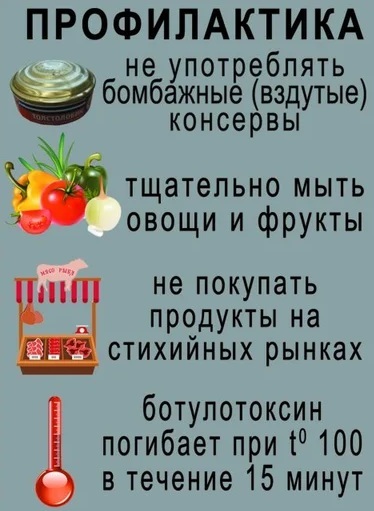
When preparing homemade canned food from meat, mushrooms, vegetables or fruits, you should strictly follow all the rules, carry out high-quality heat treatment.
It is important to use glass sterile containers and tight lids, which will prevent microbes from entering the product.
If a metal can or lid on homemade blanks is swollen, it is categorically contraindicated not only to use the product, but even to try it in order to determine the taste.
It is recommended to immediately send such products to the trash can, and sterilize the glass jar for 20 minutes. in order to destroy toxins, microorganisms.
Fresh vegetables and fruits should be thoroughly washed and boiled over to prevent contamination. When buying dairy products, you should first specify the production date and expiration date on the package. In addition, it is important not to ignore the symptoms of poisoning; at the first sign, consult a doctor.
Treatment methods
To treat the disease, several methods are used to quickly improve the patient's condition. In each case, the therapy regimen may be different.
Medications
Depending on the time that has passed since the onset of symptoms, different therapy tactics are used.
Among the standard medicines, there are several means that facilitate the course of pathology:
- Ibuprofen Is a non-steroidal anti-inflammatory drug that is often used to relieve pain and lower body temperature in the first day after infection. If the patient can swallow pills, he is prescribed 1 piece 2 times a day for 1-2 days. The drug is very effective, but it is not used for a long time. The price of tablets is from 100 rubles.
-
Reosorbilact - a blood purifier that is administered intravenously using a dropper and is highly effective. Helps to replenish the lack of fluid in the body, stimulates the kidneys and the elimination of toxins from the body. It is administered at 400 ml per day for 7-10 days. Price - from 120 rubles. for 200 ml.
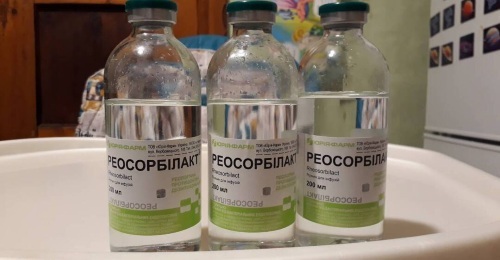
- Ringer's solution - another highly effective remedy prescribed for replenishing sodium and potassium in the body, as well as cleansing, normalizing water balance and relieving symptoms. The patient usually receives up to 500 ml of the drug per day using a dropper. The treatment lasts at least 10 days. Cost of funds - from 100 rubles.
-
5% glucose solution administered alone or in combination with ascorbic acid. It is used as a means to normalize water balance and stimulate kidney function, it is effective, as it does its job well. The patient is administered from 200 to 400 ml per day using a dropper. Treatment continues for up to 10 days. The price of a bottle of the product is from 50 rubles.
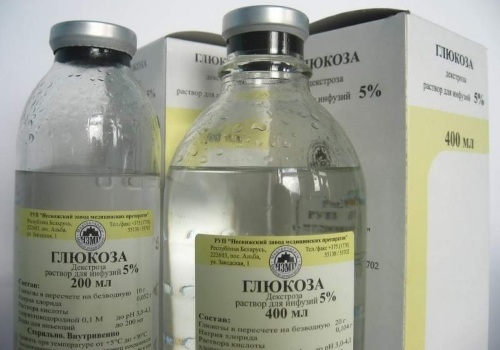
- Furosemide - short-acting loop diuretic. Helps stimulate the elimination of toxins by increasing the volume of urine. It is used in short courses of 2-3 days with daily administration of 2-4 ml of the drug intravenously in the morning. The tool is highly effective and, in combination with other medicines, accelerates recovery. Price - from 40 rubles.
- Entersgel - an agent in the form of a gel, which is used to neutralize toxins in the human intestine. The paste helps to remove toxic compounds and improves the patient's condition, reduces the frequency of bowel movements during the day. It must be taken 3 times a day for 1 tbsp. l. The duration of the course is 5-7 days. The tool is effective, its price starts from 350 rubles.
- Motilium - a drug for eliminating bloating and flatulence, is effective, is prescribed in the early stages, when the patient is able to swallow a pill. The daily dosage is 2 tablets, they can be taken at once or divided into 2 doses. Treatment with the remedy lasts no more than 5 days. Its price is from 400 rubles.
- Cerucal - a highly effective anti-nausea agent. It is used for frequent vomiting and inability to take pills. The patient is injected intravenously from 2 to 4 ml of solution per day, continued for 5-7 days. This is usually sufficient to relieve symptoms. The price of the medicine is from 200 rubles.
Such funds are used only to alleviate the condition and accelerate the evacuation of toxic substances from the body. They do not directly target the toxin and are therefore not used as the only treatment.
The most effective method of therapy is considered to be the introduction of anti-botulinum serum of type A, B or E, depending on the type of pathogen found in the body. The dosage of serum is determined individually, it is injected every 8 hours for 4 days or 2 times a day if the disease is mild.
It should be noted that serum therapy is carried out only after a sensitivity test, and also in combination with taking antihistamines and glucocorticoid medications. In addition, the serum is used only when a disease is diagnosed in the first 3 days after infection. Otherwise, it is ineffective.
Folk methods
Botulism in an adult (symptoms quite often resemble simple poisoning, which complicates the diagnosis) cannot be cured with folk remedies, but some of them are actively used to relieve states.
Most drugs are intended for oral administration, so this therapy is effective in the initial stages, when the patient is able to swallow fluids normally.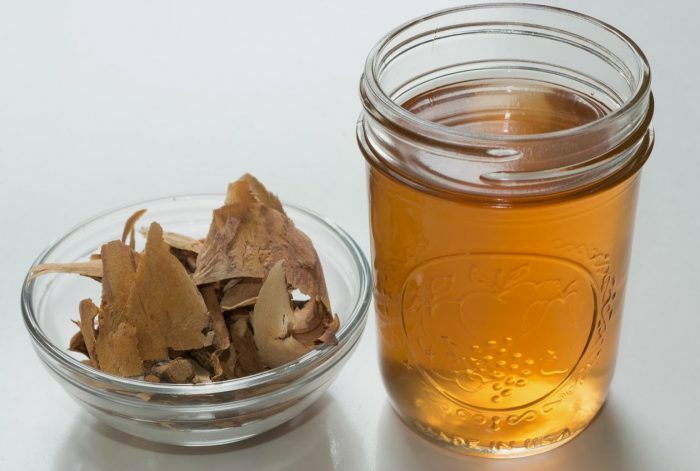
A decoction of oak bark has enveloping properties that help stop diarrhea and prevent dehydration. You can get the medicine from 20 g of dry crushed bark and 500 ml of water, cook the raw material for 10 minutes, leave for 2 hours. After that, filter the broth and take 50 ml 3 times a day. It is necessary to continue treatment for 7 days.
Chamomile infusion is considered a universal medicine for any food poisoning. It is necessary to pour 300 ml of boiling water with 5 g of dry crushed herbs, leave for 30 minutes. After that, take the filtered infusion 150 ml 2 times a day for 5-10 days.
Any folk remedy is allowed to be taken only after consulting a doctor, since symptoms may worsen.
Other methods
Other methods include emergency assistance in the form of gastric lavage and enema, as well as a special diet.
The procedure for gastric lavage and an enema is done in a hospital in the first few hours after eating low-quality products. This allows you to reduce the concentration of microbes in the body and exclude the transition of the disease to a severe form. Boiled water is used for the procedures, in each case their number is determined individually.
The diet involves eating only foods that will not cause complications. In the first 3-4 days, it is necessary to take only mineral water, which will normalize the condition of the digestive tract.
It is gradually allowed to introduce simple dishes into the diet:
- Mashed potatoes without salt and oil.
- Galette cookies.

- Buckwheat and rice porridge.
- Lenten soups with potatoes and no fried vegetables.
- Steamed vegetables.
- Mild black tea.
After 1-2 weeks, it is allowed to eat boiled lean meat, a small amount of bread, as well as boiled lean sea fish. In each case, the diet may differ slightly depending on the complications, the patient's body. The duration of its observance depends on the severity of the symptomatology of the pathology.
Possible complications
Complications can develop in the absence of treatment or with late seeking medical help. They affect the internal organs.
The most common consequences:
- Bronchitis, pneumonia.
- Myositis.
- Inflammation of the nerve endings.
- Acute respiratory failure.
- Nervous system pathologies that develop against the background of dehydration and oxygen starvation.
The most dangerous complication is death, which occurs in a few days in the absence of correct and comprehensive treatment. With timely assistance, the prognosis for the patient is favorable.
Botulism is considered a dangerous disease with a high risk of death. Symptoms can occur in an adult or a child, are rapidly aggravated and provoke severe complications. With the correct and timely assistance, the consequences can be avoided.
Botulism videos
Malysheva will talk about botulism:

